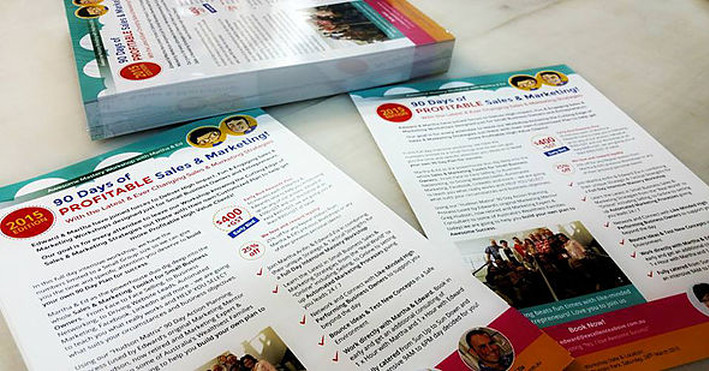Online marketing has put printed brochures on the back foot. Why spend time and money designing and publishing information that people can now find and access virtually?
Whilst there’s no denying the power of digital, it doesn’t mean we should disregard offline channels completely. Printed brochures offer unique value, reinforcing your online efforts and hitting customers where a screen cannot.
From pivotal to printed brochures
From the popular tri-fold to the glossy A4, printed brochures were once a marketing necessity. Beyond advertising and face-to-face sales, they helped businesses define their brands, showcase their products and services and concrete a call-to-action. They were the physical thread that weaved businesses into the minds of potential customers.
But in this digital age, where online offers the possibility of tighter targeted, interactive and seemingly more cost-effective promotional communications, printed brochures are losing favour. Not only are they seen as outdated and environmentally wasteful, but they are also viewed as an expense that doesn’t pay back.
However, the printed brochure is still a valuable marketing tool. Here’s why…
They establish business credibility
Anyone today can set up a website and call themselves a business, especially with the ready availability of tools such as WordPress and Wix. Because of this, people are always looking for something more to establish trust – a vital component in any business relationship.
They are your chance to impress
Not only can a brochure make you appear more credible, but it is also a great opportunity to showcase your brand and impress potential customers and clients. Again, a professional website with the right content can help you do that. But your brochure can back it up and bring it home – when done right, that is.
A well-designed, high quality brochure with clear content speaks volumes about your brand. If you put that amount of time and effort into your brochure, it can help reassure people that you will do the same for your customers. It also gives you a unique opportunity to stand out.
Printed brochures are an effective direct marketing tool
Unfortunately, there are not as many statistics out there today on the effectiveness of brochures as a marketing tool. This is probably because everyone is too busy worrying about the analytics of their online activities. But we do know that tangible marketing collateral that falls straight into the hands of consumers and clients does work.
Whether you are handing them out at a tradeshow or sending them out as part of a targeted direct mail campaign, a physical brochure has a high chancer chance of being retained and read – websites and word-of-mouth can be forgotten; emails can be deleted. Sure, brochures can and do get thrown away, but the process requires more thought.
They are your silent sales person
If kept, a brochure becomes a constant reminder of your business to that potential customer or client. Every time they catch sight of it, whether on their desk, coffee table or even in their drawer, your business is again pushed to the front of their mind. It is quietly whispering ‘’Buy from us’’, ‘’Get in touch’’ or ‘’Find out more’’.
People like something tangible like printed brochures
Despite the move to digital, tangibility still holds value to a lot of people. Just ask yourself the following question: why do people still print pages from the internet if online marketing communications suffice? Ultimately, they still like something they can pick up, touch and hold onto. Plus, many people are simply tired of looking at screens.
Depending on what industry you are in, their tangibility offers varying appeal. For example, a person searching for a second-hand car might like the ability to circle the ones they are interested in. By comparison, a person keen to take a holiday might be looking for something they can take away and peruse at their leisure.
Don’t stop the press
Despite the shift to digital, printed brochures are still relevant. In fact, when designed and distributed right, they can be a vital component in pushing potential customers or clients from engaged to interested to sold. Instead of writing them off as a wasted marketing effort, we should instead be focusing on the unique benefits they offer.


Leave A Comment